MXA’S 2015 SUZUKI RM-Z450 MOTOCROSS TEST: THE ACRONYM
Q: FIRST AND FOREMOST, IS THE 2015 SUZUKI RM-Z450 BETTER THAN THE 2014 RM-Z450?
A: Yes. Why? Last year, Suzuki’s complete list of updates on the 2014 RM-Z450 consisted of changing the side panels from white to yellow. Heady stuff. So, for 2015, the new air forks, revised frame and extra electronic gizmos ensure that the 2015 RM-Z450 is an improvement over the 2014 model.
Q: WHAT DID SUZUKI CHANGE ON THE 2015 RM-Z450?
A: Quite a few things, and one of them of major importance, but let’s analyze what they did in 2013 and 2014 first.
Last year, Suzuki’s complete list of updates consisted of changing the side panels from white to yellow and some gobbledygook about a single-spark ignition that turns into a dual-spark ignition or vice versa. But, they had two different explanations about how it worked, so let’s forget that mod, because it didn’t add anything to the package anyway.
MXA cut Suzuki some slack for its benign neglect of the 2014 RM-Z450 because, after all, they had gone through bankruptcy court and had given the 2013 RM-Z450 a 13-percent-lighter piston, DLC piston pin, 0.4mm-higher lift cam, three-dog gears, more magneto power, a redesigned muffler, enlarged air boot, and Showa SFF single-spring forks.
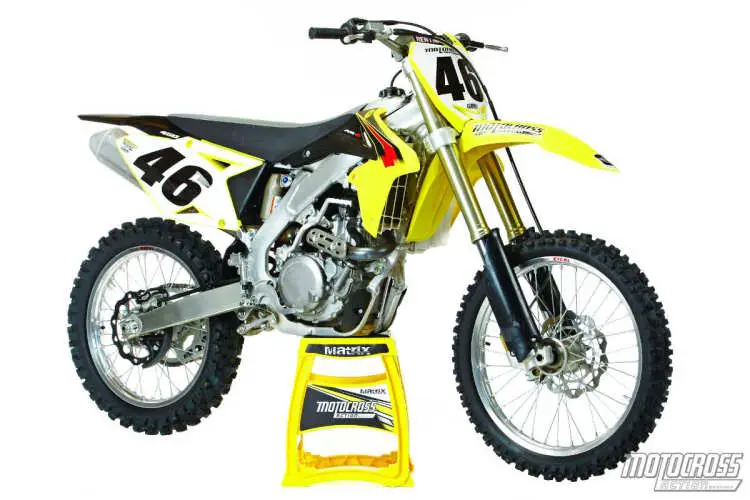
The big changes for 2015 are:
(1) Showa SFF Air TAC forks. No forks on the planet were as bad as the 2014 Suzuki Showa SFF forks. It would take a reading on the Richter scale to get movement out of these forks. “Bad” is too good a word for them. Thus, 2015 sees an all-new fork, also used on the 2015 KX450F and CRF250. The new fork is still a Showa SFF fork, but unlike last year’s single-sided coil-spring design, the 2015 version is a single-sided air-spring version with Triple Air Chambers (TAC). The air is in the right leg and the damping is in the left. There is no coil spring, but there is a complex interplay of air pressures.

(2) S-HAC launch control. Okay, they can’t call it “Launch Control” because Kawasaki got there first with the naming rights. So, Suzuki calls it Suzuki Holeshot Assist Control (S-HAC) to prove that they are bad with acronyms. In keeping with the complexity of the SFF TAC air forks, Suzuki S-HAC one-ups Kawasaki’s Launch Control system with three different programmable modes. The A-Mode is for concrete-like, rock-hard dirt or slippery starting pads (you access A-Mode by holding the button down for 0.7 seconds). The B-Mode is for loam, good dirt and plentiful traction (you access it by holding the button down for more than 1.8 seconds). And, of course, if you don’t hold any buttons down, you have the stock ignition map. The stock map and the B-Mode seem redundant and from any rational evaluation this is one holeshot setting too many.
(3) Longer kickstarter. The kickstart lever is 30mm longer than last year’s, and the drive and idler gears were changed to complement it. It does start a little better, but you have to really lift your leg up to get a full swing.
(4) Frame. The aluminum frame is 4 percent lighter than last year and claims to have reduced rigidity. These changes come via a new downtube and redesigned ribbing on the main spars.
(5) Hoses. The radiator hose connector has been changed from a T-shape to a Y-shape design to equalize water flow between the left and right radiators. Plus, a new water-pump cover increases water flow by 16 percent. This was much needed because on the starting line the previous RM-Z450s could percolate a pot of coffee — if you were willing to lick it off the ground under the bike.
(6) Shift cam. To help with shifting, a revised gear shift cam, not the shift lever, has been set up for more precise movements.
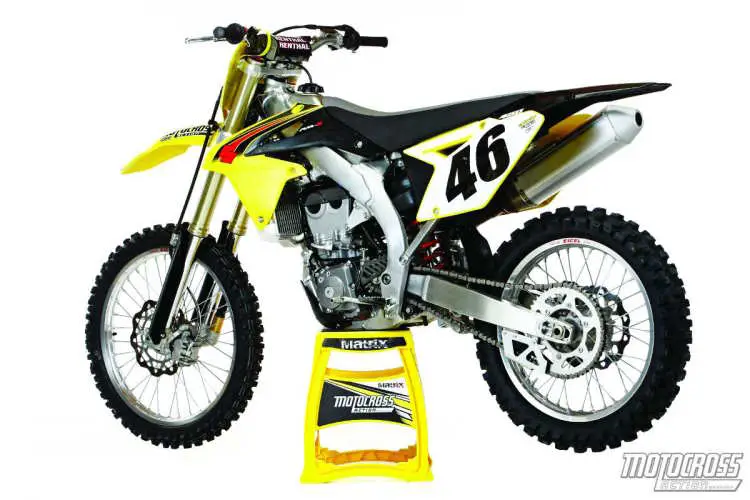
Q: WHAT WOULD MXA HAVE LIKED SUZUKI TO CHANGE FOR 2015?
A: As with every bike we test, we have a hits-and-misses list—and no bike ever comes perfect from the factory. Suzuki deserves kudos for 2015 because they made a serious effort to fix two things on last year’s list—the terrible forks and the RM-Z450’s tendency to boil over.
Here is what’s left to do:
(1) Looks. Never cutting-edge in the looks department to begin with, Suzuki continues to produce the same basic aesthetics package from 10 years ago. Oh, the seat cover color and shroud decals have changed over the years, but this is a stale design.
(2) Clutch. Suzuki shouldn’t be allowed to call what comes on the RM-Z450 a clutch. It should be called a “fiber plate disintegrator.” Don’t try to race this bike without stiffer clutch springs.
(3) Rear brake adjustment. Suzuki’s rear pedal has a very narrow window of adjustment. Caveat: There must be free play in the master cylinder’s slotted clevis.
Q: HOW FAST IS THE 2015 SUZUKI RM-Z450?
A: It’s not as fast as it is nice. The RM-Z450 has a very well-placed low-to-mid powerband that works best if you shift at peak. It isn’t as fast or broad as what KTM, Yamaha, Husqvarna or Kawasaki are offering, but it makes up for its power shortcomings with almost perfect power placement. Every MXA test rider likes the Suzuki RM-Z450 engine. There are faster engines on the track, but not necessarily engines that allow you to go as fast as on the mellower Suzuki. Of course, going fast on an engine that gives up as much as two horsepower to its hyperkinetic competition means that you need a talented left foot to keep working the sweet spot, which is definitely not in the upper reaches of the realm. You have to shift to make the most of what the RM-Z450 delivers. Top-end power and over-rev are not the RM-Z450’s strong points, so you have to get into taller gears to get the engine to pull longer.
Just so you know, the 2015 Suzuki RM-Z450 makes 54.77 horsepower at peak. That is a healthy number, but actually fifth best in the 2015 horsepower sweepstakes. Yamaha (56.90), Husky (56.62), KTM (56.48) and Kawasaki (55.06) all make more power. The Suzuki does beat the 53.03 output of the 2015 Honda CRF450. But all is not a downer. The Suzuki makes power that puts in the top spot at 6000 rpm and the second-to-top spot at 8000 rpm. And, it produces the most torque of all six 450s. However, all the good stuff happens before 8000 rpm — after that it is blue, white, orange and green world.
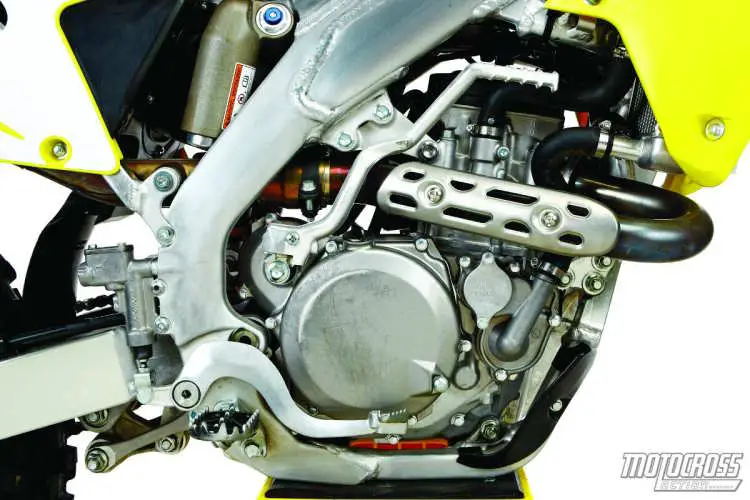
Q: WHICH PLUG-IN MAP IS BEST?
A: Suzuki offers three different map couplers that can be plugged in to change the powerband. Here is how they work.
Black coupler: Black is the stock coupler, and it works across a wide range. Strangely, the black coupler was the best map for the dyno, but it was not the first choice of test riders for racing.
Gray coupler: On hard, dry and slippery tracks, this plug-in is worth its weight in gold. It fine-tunes the power delivery so the rider can use the power to its fullest by not allowing the engine to produce power to its fullest. This is definitely not the map you would want for loam, sand or well-prepped dirt.
White coupler: Strangely, the white coupler produces the best on-track power, but the dyno doesn’t see it. That’s not all that odd, as the dyno never saw any advantage to long-rod Yamaha YZ250 two-stroke engines, but every test rider did. For the MXA wrecking crew, the white coupler is the best choice because it adds personality to the RM-Z450’s powerband.
Q: HOW DOES THE 2015 RM-Z450 HANDLE?
A: It handles the same as all Suzukis have handled since 1982. The 2015 RM-Z450 is unsettled at speed. It gets twitchy over rough ground and can be a bit of a bucking bronco in potholes; however, we don’t think that fear of high-speed head-shake is a good enough reason to give up the RM-Z450’s prowess at low speeds. The RM-Z450 trades any semblance of civility at high speed for a chassis that carves like Douglas Fairbanks’ sword work in the turns. It can turn inside any bike, save for another Suzuki, with ease. There is no hesitation in tight turns; this bike wants to turn. If you ride on supercross-style tracks, flat tracks with lots of jumps or tracks that aren’t rough, this is the chassis for you.
There are two caveats to Suzuki handling:
(1) Motocross handling is a compromise. A bike has to be able to turn tight turns at low speed but still dance across high-speed straights while bouncing off the tops of the rubble. As a rule of thumb, extremely stable bikes don’t turn, and bikes that turn aren’t as stable at speed. For once, common sense is 100 percent accurate.
(2) Fork height is critical on the RM-Z450 because of its unique frame geometry. If you lower the fork legs too much into the clamps, the RM-Z450 will become more stable, but it will turn like a wheelbarrow (or a Kawasaki). If you slide the fork legs too high up in the triple clamps, the bike will oversteer. For every track, there is a perfect balance point. It’s up to you to find it by fiddling with race sag and fork height.
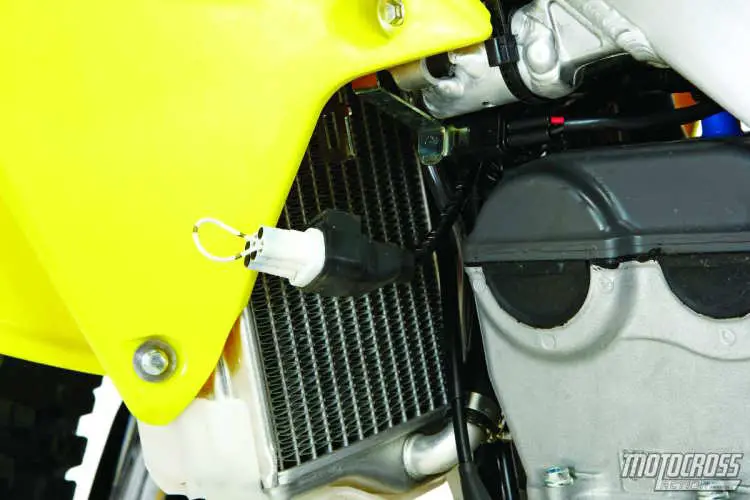
Q: HOW GOOD ARE THE SHOWA SFF AIR TAC FORKS?
A: First and foremost, they are light years better than the RM-Z450 forks that Suzuki foisted on the buying public in 2014. Rigid pieces of lumber are better than Suzuki’s 2014 forks. That said, the 2015 Showa SFF Air TAC forks are a blessing — once you find the right numbers.
The Triple Air Chamber forks have three distinct air pockets (inner, outer and balance). And, if all you had to do was put air in them and go ride, life would be sweet; but, it’s not that simple. Every time you change the pressure in one chamber, it affects the pressure in the other two chambers.
Worse yet, Suzuki and Kawasaki are on different planets when it comes to air pressure settings (and these forks aren’t all that different from each other). It’s obvious to us that when two identical forks have a 30 psi difference in their recommended settings, the consumer is in for a bumpy ride. The MXA wrecking crew believes that Suzuki is a lot closer to the correct air spring pressures than Kawasaki, but suffice it to say that they both need lots of testing to get dialed in.
Q: WHAT HAPPENS WHEN THE TAC FORKS ARE SET UP WITH THE WRONG AIR PRESSURE?
A: The possibilities are endless—and not pretty—but let’s focus on the two most common issues.
(1) Too much air in the inner chamber. If you run too much air pressure in the inner chamber, because of your weight, speed or track, the SFF TAC forks stop being resilient in the corners. Instead of following the terrain in fast sweepers, they deflect off the ground. It’s not easy to turn if the front tire keeps pushing outwards. If your TAC-equipped bike doesn’t allow the front tire to bite in fast corners, you have too much air in the inner chamber; however, you cannot fix it by just lowering the air pressure in the inner chamber.
(2) Not enough air in the inner chamber. If you run less air, you will bottom everywhere, and you will bottom hard, which will force you to put more air pressure in the inner chamber. This, of course, will cause the front end to deflect off bumps and negatively affect cornering.
Why does this conundrum happen? Because the inner air chamber works in relationship with the other two chambers. You can’t fix one without adjusting the others.
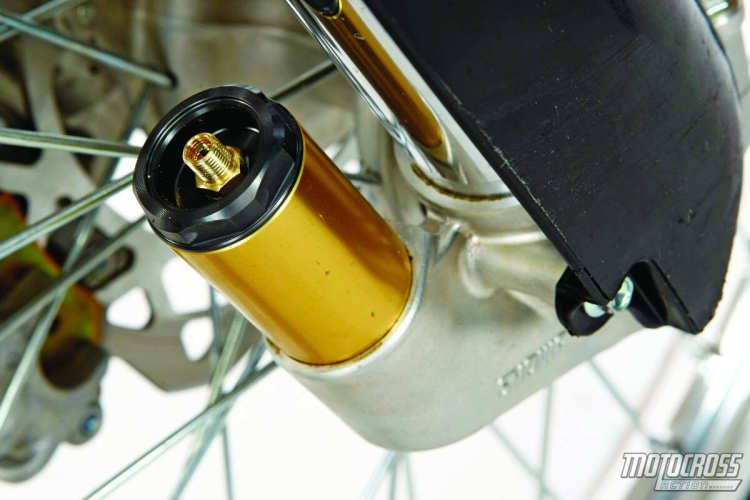
Q: WHAT IS THE SFF AIR TAC SETUP SECRET?
A: You can’t fix it until you understand what the three chambers do.
Inner chamber. In simplest terms, this is the main fork spring. It holds the bike up. It essentially replaces the coil springs of a conventional fork with 174 pounds of air pressure.
Outer chamber. On the Suzuki, the outer chamber is set at 0 psi air pressure, while Kawasaki recommends 7.3 psi. Think of the outer chamber as a large-volume/low-pressure air pocket that can add spring resistance late in the stroke.
Balance chamber. Also known as the negative spring, the balance chamber works in direct opposition to the other two air chambers. The pressure in the inner and outer chambers push the fork downward towards the ground. Conversely, the balance chamber pushes the fork upwards, away from the ground, to eliminate topping out when the front wheel is off the ground. The relationship between the inner spring and the balance spring is very touchy. If you add air pressure to the inner spring, the fork will get longer and the preload on the air spring will be greater. If you add air pressure to the balance spring, the fork will get shorter and the preload on the main air spring will be reduced.
Our best setup involves choosing an inner spring pressure that makes the forks feel supple across rough ground, doesn’t dive excessively, and allows the forks to drop in without holding the front too high. Then, we set the balance chamber pressure to either soften or stiffen the overall feel of the fork. Remember this: more air in the balance chamber will soften the forks, less air will stiffen them. Finally, we use the outer chamber’s air pressure to stop bottoming, typically adding 10 to 15 psi. When you get the relationship between the three pressures correct the forks feel very good — but as with all forks, regardless of what holds them up, the compression and rebound clickers still need careful setup.
Q: WHAT DID WE HATE?
A: The hate list:
(1) Clutch. This clutch has always been an embarrassment. If you use it, you will lose it.
(2) Shifting. The RM-Z450 has a very light feel at the shift lever, which in theory is a great trait, but in action, it sometimes leads to missed shifts and the occasional mystery shift.
(3) Throttle grip. If you want to install aftermarket grips on the RM-Z450 throttle tube, lots of luck. It is vulcanized on.
(4) Brakes. Suzuki’s brakes were nothing special when only KTM knew what it was doing in the stopping department. But now that Honda and Kawasaki have joined KTM and Husky in the oversize front-rotor brigade, Suzuki has dropped two more notches…and there aren’t a lot of notches left to drop.
(5) Aesthetics. It’s as though Sherman and Mr. Peabody designed the 2015 RM-Z450 after a trip to 2007 in the Way-Back Machine.

Q: WHAT DID WE LIKE?
A: The like list:
(1) Handling. If you want to improve your cornering prowess, a Suzuki RM-Z450 will do it on the first lap. If you want to get religion, a Suzuki RM-Z450 will do that on the first whooped-out, fifth-gear straight.
(2) Powerband. This engine doesn’t set the world on fire, but it is very good. It has well-placed power and a very usable spread. What it lacks in raw thrust, it makes up for with an easy-to-use delivery.
(3) Tires. Even though they are on the road to being discontinued, Bridgestone’s 403/404 tires are an MXA favorite.
(4) Cooling. The RM-Z450 doesn’t steam clean the starting line while you are waiting for the gate to drop anymore.
Q: WHAT DO WE REALLY THINK?
A: This is a strange machine. It doesn’t have superlative horsepower, clutch, brakes, stability, looks or ergos. Yet, the MXA test riders love what the RM-Z450 feels like in motion. Its one and only great trait is cornering—and for many riders, that is worth the price of admission. ❏
MXA SUZUKI RM-Z450 SETUP SPECS
This is how we set up our 2015 Suzuki RM-Z450 for racing. We offer it as a guide to help you get your own bike dialed in.
SHOWA SFF TAC FORK SETTINGS
There is an old saying in motocross about adjustable suspension—“20 clicks of adjustment…and 19 of them wrong.” This is how we feel about the Showa TAC forks. They are very complex, They have three different air pressures valves, four oil heights and 20 clicks of both compression and rebound. It is sensory overload, especially because each change brings with it a mutation in all of the other adjustments.

That said, stick close to MXA’s specs. You will need to fine-tune the pressures for your speed and weight, but remember that the inner chamber and balance chamber pressures work in relationship to each other, and that the outer chamber, which gets short shrift from both Suzuki and Kawasaki, can be used as booster air pressure at the end of the fork’s stroke to lessen bottoming.
For hardcore racing, we recommend this fork setup for the 2015 Suzuki RM-Z450 (stock specs are in parentheses):
Inner spring rate: 170 psi (174 psi)
Outer spring rate: 10 psi (0 psi)
Balance spring rate: 174 psi (174 psi)
Oil height: 340cc (left leg), 100cc (inner chamber), 300cc (outer chamber), 10cc (balance chamber)
Compression: 12 clicks out (8 clicks out)
Rebound: 11 clicks out (13 clicks out)
Fork leg height: 5mm up
Notes: You cannot recheck the air pressure with your fork pump (Suzuki does not provide a pump with the forks, although Kawasaki does). Because of the high pressures in the inner and balance chambers, air leaks back into the pump and ruins the ability to get an accurate reading. So, never use the pump to check the air pressure; instead, use the pump to reset the air pressure to your desired setting. It helps if you write your air pressures down in a notebook (or on the front fender as the MXA wrecking crew does).
SHOWA SHOCK SETTINGS
For hardcore racing, these are MXA’s recommended 2015 Suzuki RM-Z450 shock settings (stock settings are in parentheses):
Spring rate: 5.5 kg/mm
Hi-compression: 1-1/2 turns out (2 turns out)
Lo-compression: 10 clicks out (12 clicks out)
Rebound: 9 clicks out (10 clicks out)
Race sag: 104mm
Notes: In an attempt to find a better fore/aft balance, the high-speed compression adjuster can be used to help keep the chassis flat.


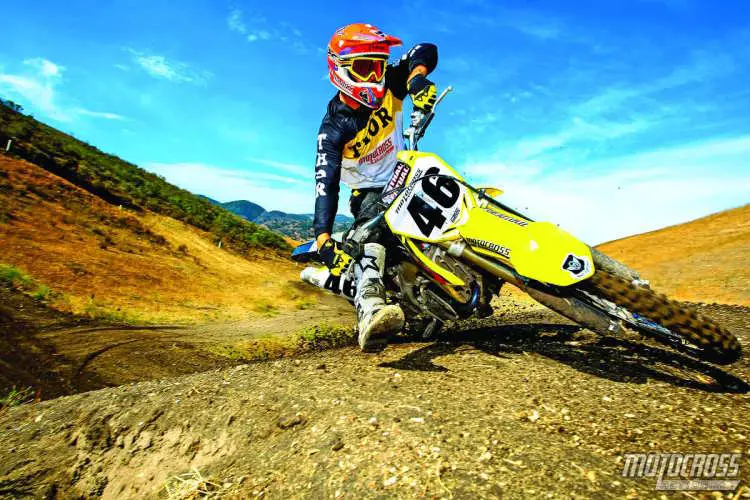

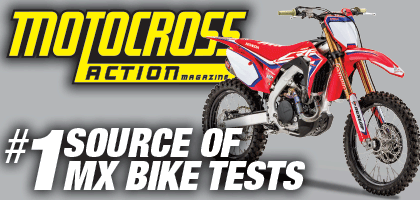


Comments are closed.